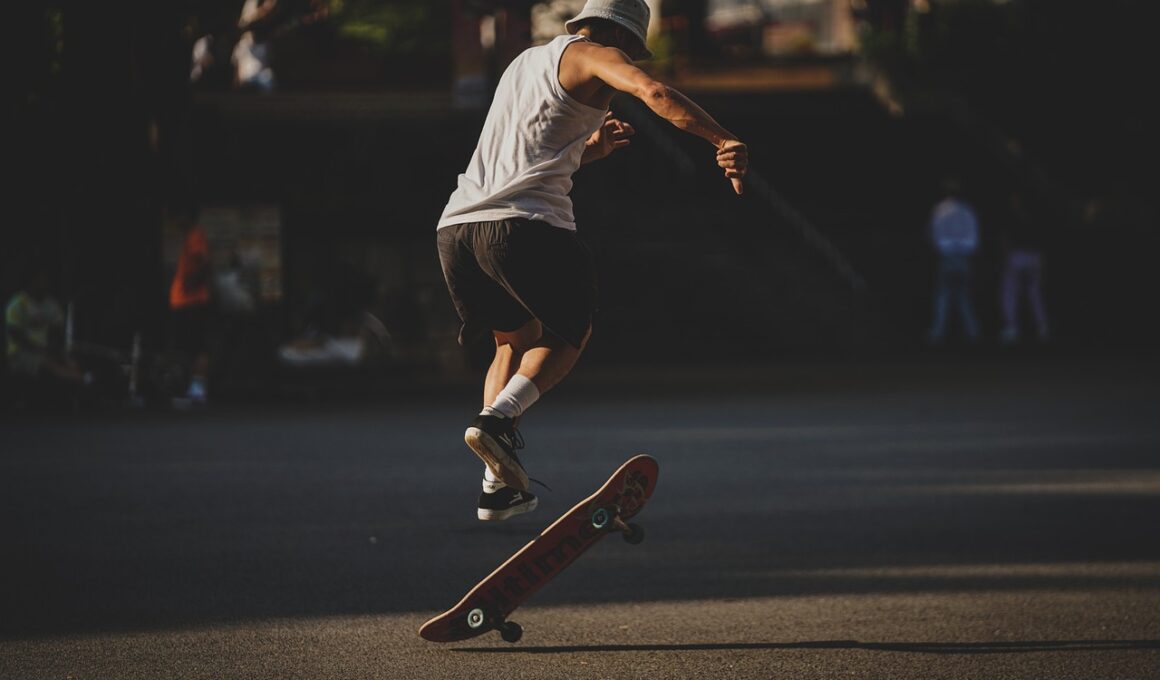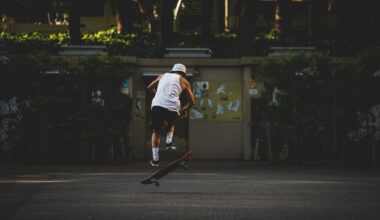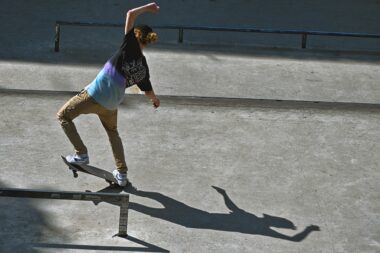Advanced Footwork for Improved Skateboard Control
To master advanced footwork for better skateboard control, a skater must focus on precision and timing. Improving foot placement helps the rider adapt movements while executing tricks. This includes practicing foot speed with exercises that challenge balance and agility. Establishing a strong footing is vital; it allows a skater to shift between tricks seamlessly. When optimizing footwork, consider including ladder drills as they enhance quick foot actions. Skaters should also perform ollies and pop shoves frequently to reinforce muscle memory. As the feet become accustomed to shifting weight, control becomes natural, allowing for effortless transitions between moves. Monitoring body balance while shifting weight is essential; it aids the skater’s ability to turn and pivot smoothly, mitigating falls. Furthermore, performing technical tricks such as varial flips test foot coordination and control. These tricks develop strength in ankle joints, providing necessary support. A successful skater always aims to master footwork, integrating foot positioning, balance, and timing with every trick. In essence, the foundational practice of footwork is what separates an average skater from an advanced one, noticeably improving overall performance.
Drills for Enhancing Footwork Skills
Engaging in specific drills can significantly enhance footwork skills. One effective drill is the “front foot back foot” exercise, which emphasizes weight distribution on either foot while executing tricks. Skaters can also practice pivot spins—turning 360 degrees while stationary—providing a solid grasp of foot control during turns. Another beneficial practice is performing “jumping jacks” on the skateboard to help improve both balance and foot coordination. To further refine footwork, consider utilizing a balance board; it enhances stability while challenging foot agility in a dynamic way. Transitioning tricks requires precise foot movements; thus, performing tricks over small obstacles helps condition skaters to anticipate foot placement. A focus on maintaining a low center of gravity proves crucial; flexibility in the knees promotes easier shifts in weight. Incorporating these footwork drills into routine practice can speed up a progression from beginner to advanced skating levels. Remember, frequent repetition is key for developing muscle memory, ensuring quality execution of tricks becomes instinctive. Additionally, collaborating with peers for feedback can introduce a new perspective on foot placement challenges and areas for improvement.
Further, cornering techniques significantly rely on adept footwork. Skaters enhance their proficiency specifically by learning to edge effectively while shifting weight. This involves a keen awareness of changing foot positions during turns, working toward smoother transitions. Turning shapes like the carve or the tight circle rely heavily on foot placement and pressure. Depending on the desired direction, positioning the front and back foot correctly minimizes friction with the board. When attempting to corner sharply, focusing weight on the front foot aids in maintaining control and preventing slips. Implementing practice runs in various environments—like parks or ramps—encourages skaters to feel different responses from the board based upon foot adjustments. Effective edging further complements sliding techniques, allowing skaters to execute controlled slides with precision. Sliding maneuvers, such as the bluntslide, are compatible with advanced foot positioning. Importantly, maintaining a relaxed posture aids in absorbing terrain changes and sudden speed adjustments. Advanced footwork fosters agility, thus enhancing overall skateboarding performance. Familiarizing oneself with different foot techniques establishes a foundation allowing skaters to experiment with unique styles. Explore ideas concerning footwork by watching skilled peers or searching online for tutorials.
Importance of Foot Placement
Perfect foot placement critically influences a skateboard’s responsiveness during tricks. A mispositioned foot can lead to untimely slips, affecting balance while attempting maneuvers. When executing tricks such as kickflips, it’s paramount that skaters position their back foot near the tail for optimal pop. Meanwhile, the front foot must remain placed accurately to initiate the flip while balancing. Feet must remain engaged throughout all phases of the trick: the pop, the spin, and the catch. To enhance this accuracy, skaters may benefit from visualizing the foot’s path prior to attempting each trick. Incorporating visualization sets a strong mental roadmap leading up to trick execution, reducing anxiety that may arise from pressure. This mental rehearsal can establish confidence which is vital for consistent progress in maneuvers. Skateboards inherently respond differently depending on the terrain; this variability indicates that foot placement is never static. Therefore, consistent reflection on foot positioning aids in mastering advanced tricks. As footwork becomes refined, skaters can explore and create unique adaptations to infuse personal style. Developing a thorough understanding of foot placement is undeniably key to becoming an advanced skateboarder.
Additionally, achieving mastery in footwork correlates with increased creativity on the skateboard. As foot control improves, skaters gain the ability to incorporate diverse tricks and combinations seamlessly. Creative expression is celebrated in skate culture; thus, developing footwork will provide an avenue for originality. Learning to blend slight variations into standard tricks contributes to an individual’s signature style. For example, performing a simple grind followed by a clean kickflip can set one apart from peers. Practice transitioning quickly between such tricks supports a smooth flow that captures the essence of skateboarding artistry. Skaters should keep experimenting with foot movements to discover novel approaches to traditional tricks. Engaging in freestyle practices boosts the skater’s ability to improvise effectively while still maintaining stability on the board. A critical component of creativity lies in being fearless; finding joy in the discovery promotes willingness to push boundaries. Together, foot placement and creativity harmonize to present an advanced skateboarding skill set. Advanced skateboarders often inspire onlookers, encouraging new skaters to explore their potential, thereby fostering the growth of skateboarding as a dynamic sport.
Building a Routine for Effective Practice
Creating an effective practice routine is fundamental for refining footwork. The first aspect to consider is consistency; dedicating specific times weekly to practice ensures steady improvement. Dividing practice sessions into shorter segments keeps focus and energy levels high. Begin with warm-ups, including stretches and light exercises that activate the muscles needed for foot maneuvers. Next, allocate time for footwork drills focusing on precision and adaptation. Identifying personal weaknesses can guide tailor-made exercises enabling targeted skill enhancements. Incorporate balance challenges such as standing on one leg or simple hops on the board to strengthen proprioception. Additionally, working on foot speed through sprinting in place can improve reaction times during tricks. Review recorded sessions to analyze foot positioning changes and to reinforce muscle memory effectively. Ending each session with freestyle creates opportunities to engage creatively, applying new skills learned in real-time. Maintaining a balance of technical focus along with creative exploration ensures a well-rounded development. Over time, this focused approach ingrains advanced footwork into the skateboarding routine, building confidence and facilitating smoother tricks.
Lastly, integrating footwork-specific jumping techniques can also elevate skating skills substantially. Jumps, such as the gap jump or drop-in, require both careful foot placement and a solid understanding of balance. When preparing to execute jumps, ensuring feet are positioned symmetrically allows for an equal weight shift. Practicing landing skates on flat terrain is essential; it develops the ability to absorb shocks upon landing effectively. Jumps can be challenging; hence practicing mental preparation is equally crucial. Visualizing the gap or the landing can help reduce potential failures, ensuring better execution. This mental rehearsal can be incorporated into warm-up routines, creating a well-rounded approach toward jump-specific training. Both landings and takeoffs rely on seamlessly coordinated foot movements. Understanding how much pressure to apply when landing enables skaters to prevent injuries linked with awkward shifts. By fusing jumps with footwork practice, skaters gain comfort and finesse on the board. Ultimately, mastery of advanced footwork not only enriches skateboarding technique but also cultivates an overarching love for the sport, transforming riders into well-rounded athletes.





